ڤينوس (أسطورة)
فينوس إحدى أهم الإلهات في الأساطير الرومانية. كانت أساسًا إلاهة الحب والجمال، ولكن أصبحت فيما بعد ترمز إلى القوة الخلاقة التي تمد بأسباب الحياة. وقد زعموا أن لها ابنًا هو كيوبيد المُسمَّى إله الحب عند الرومان، وتقابل فينوس، الإلهة أفروديت عند اليونان.
كنى ڤينوس
Venus Acidalia, possibly derived from the Fountain of Acidalia, where the Graces (Venus' daughters) were said to bathe[2]
Venus Caelestis (Celestial or Heavenly Venus), used from the 2nd century AD for Venus as an aspect of a syncretised supreme goddess. Venus Caelestis is the earliest known Roman recipient of a taurobolium (a form of bull sacrifice), performed at her shrine in Pozzuoli on 5 October 134. This form of the goddess, and the taurobolium, are associated with the "Syrian Goddess", understood as a late equivalent to Astarte, or the Roman Magna Mater, another supposedly "Trojan Mother of the Romans"[3]
Venus Calva ("Venus the bald one"), a legendary form of Venus, attested only by post-Classical Roman writings which offer several traditions to explain this appearance and epithet. In one, it commemorates the virtuous offer by Roman matrons of their own hair to make bowstrings during a siege of Rome.
Venus Erycina ("Venus of Eryx"), captured from Sicily and worshiped in Romanised form by the elite, and respectable matrons, at a temple on the Capitoline Hill. A later temple, outside the Porta Collina and Rome's sacred boundary, may have preserved some Erycinian features of her cult. It was considered suitable for "common girls" and prostitutes.[4][5]
Venus Frutis honoured by all the Latins with a federal cult at the temple named Frutinal in Lavinium.[6]
Venus Kallipygos ("Venus with the beautiful buttocks"), worshiped at Syracuse.
Venus Libertina ("Venus the Freedwoman"), probably arising through the semantic similarity and cultural inks between libertina (as "a free woman") and lubentina (possibly meaning "pleasurable" or "passionate").
Venus Murcia ("Venus of the Myrtle"), merging Venus with the little-known deity Murcia (or Murcus, or Murtia).
Venus Obsequens ("Indulgent Venus"[7]), Venus' first attested Roman epithet.
Venus Physica: Venus as a universal, natural creative force that informs the physical world. She is addressed as "Alma Venus" ("Mother Venus") by Lucretius in the introductory lines of his vivid, poetic exposition of Epicurean physics and philosophy, De Rerum Natura. She seems to have been a favourite of Lucretius' patron, Memmius.[8]
الأساطير والأدب


تروي الأسطورة أن فينوس كانت أم إينياس أحد جدود مؤسسي روما الأسطوريين. عبدها أهالي روما لارتباطها بالتاريخ المبكر لمدينتهم وخصصوا لها بعضًا من معابد روما. كما اعتقدوا أن عائلة الحاكم يوليوس قيصر انحدرت من فينوس.
أدّت فينوس دورًا مهما في أسطورة تعرف باسم حكم باريس، حيث طالبت كل من فينوس والإلاهتين جونو ومينيرفا بتفاحة ذهبية كانت تمنح جائزة لأجمل الآلهه. وقد أمر الإله جوبيتر باريس وهو ابن بريام ملك طروادة، بتسوية هذا الأمر واختيار أجمل واحدة من الإلاهات الثلاث. منح باريس التفاحة لفينوس. وحرصت كل من جونو ومينيرفا على تدميرطروادة تدميرًا كاملاً أثناء حرب طروادة لكي ينتقمن من باريس.
أصبحت فينوس مادة دسمة للرسامين. رسمها كثير منهم وهي تعجب بنفسها في المرآة، كما رسم آخرون منظر حكم باريس أو أظهروا فينوس معمارس وأدونيس.

تاريخ عبادتها ومعابدها
بدأت طائفتها في آرديا وليفينيوم، لاتسيو. في 15 أغسطس 293 قبل الميلاد ، هي صاحبة أقدم معبد مكرس لعبادتها و في يوم 18 اغسطس كان هناك مهرجان يسمى فيناليا روستيكا.
في سنة 215 قبل الميلاد، كرس معبد فينوس علي التلال للاحتفال بذكرى هزيمة الرومان في معركة بحيره تراسيمني.
في الفن
الفن الكلاسيكي
Roman and Hellenistic art produced many variations on the goddess, often based on the Praxitlean type Aphrodite of Cnidus. Many female nudes from this period of sculpture whose subjects are unknown are in modern art history conventionally called 'Venus'es, even if they originally may have portrayed a mortal woman rather than operated as a cult statue of the goddess.
الأمثلة تضم:
- Venus de Milo (130 BC)
- Venus de' Medici
- Capitoline Venus
- Esquiline Venus
- Venus Felix
- Venus of Arles
- Venus Anadyomene (also here)
- Venus, Pan and Eros
- Venus Genetrix
- Venus of Capua
- Venus Kallipygos
- Venus Pudica
فن القرون الوسطى
 Venus, setting fire to the castle where the Rose is imprisoned, in the medieval French romance Roman de la Rose. In this story Venus is portrayed as the mother of Cupid |
الفن في التقليد الكلاسيكي
Venus became a popular subject of painting and sculpture during the Renaissance period in Europe. As a "classical" figure for whom nudity was her natural state, it was socially acceptable to depict her unclothed. As the goddess of sexuality, a degree of erotic beauty in her presentation was justified, which appealed to many artists and their patrons. Over time, venus came to refer to any artistic depiction in post-classical art of a nude woman, even when there was no indication that the subject was the goddess.
- The Birth of Venus (Botticelli) (c. 1485)
- Sleeping Venus (c. 1501)
- Venus of Urbino (1538)
- Venus with a Mirror (c. 1555)
- Rokeby Venus
- Olympia (1863)
- The Birth of Venus (Cabanel) (1863)
- The Birth of Venus (Bouguereau) (1879)
- Venus of Cherchell, Gsell museum in Algeria
- Venus Victrix, and Venus Italica by Antonio Canova
In the field of prehistoric art, since the discovery in 1908 of the so-called "Venus of Willendorf" small Neolithic sculptures of rounded female forms have been conventionally referred to as Venus figurines. Although the name of the actual deity is not known, the knowing contrast between the obese and fertile cult figures and the classical conception of Venus has raised resistance to the terminology.
معرض صور
Venus Anadyomene (ca. 1525) by Titian
Venus with a Mirror (ca. 1555) by Titian
Venus by Frans Floris, Hallwyl Museum
Venus looking in the mirror, with Cupid attending, painting ca. 1650 - 1700, by Peter Paul Rubens
Mars Being Disarmed by Venus (1822–25) by Jacques-Louis David
Birth of Venus (1863) by Alexandre Cabanel
Tannhäuser in the Venusberg (1901) by John Collier
Russian Venus (1926) by Boris Kustodiev
Iris presenting the wounded Venus to Mars by Sir George Hayter, 1820 - Ante Library, Chatsworth House]]
See also
- Sailor Venus (Fictional Character based on myth from series Sailor Moon)
- Love goddess
- Venus (planet)
- Venus symbol
- Hottentot Venus
- The Golden Bough (myth of Aeneas, son of Venus)
- Astaroth
References
- ^ Description from Walters Art Museum
- ^ http://latinlexicon.org/definition.php?p1=2000619
- ^ Turcan, p. 141 - 143.
- ^ Beard et al, Vol 1., pp. 80, 83: see also Livy Ab Urbe Condita 23.31.
- ^ Thomas A. J. McGinn, Prostitution, Sexuality, and the Law in Ancient Rome, Oxford University Press, 1998, p.25.
- ^ Paulus-Festus s. v. p. 80 L: Frutinal templum Veneris Fruti. Strabo V 3, 5: "At the midway between Ostia and Antium lies Lavinium that has a sanctuary of Aphrodite common to all Latin nations, but which is under the care of the Ardeans, who have entrusted the task to intendents".
- ^ خطأ استشهاد: وسم
<ref>غير صحيح؛ لا نص تم توفيره للمراجع المسماةReferenceA - ^ Elisabeth Asmis, "Lucretius' Venus and Stoic Zeus", Hermes, 110, (1982), p. 458 ff.
- ^ Sometimes interpreted as Eros-Cupid, as a symbol of the sexual union between the goddess and Anchises, but perhaps alluding also to the scene in the Aeneid when Dido holds Cupid disguised as Ascanius in her lap as she falls in love with Aeneas.
Sources
- Beard, M., Price, S., North, J., Religions of Rome: Volume 1, a History, illustrated, Cambridge University Press, 1998.
- Champeaux, J. (1987). Fortuna. Recherches sur le culte de la Fortuna à Rome et dans le monde romain des origines à la mort de César. II. Les Transformations de Fortuna sous le République. Rome: Ecole Française de Rome, pp. 378–395.
- Eden, P.T., "Venus and the Cabbage," Hermes, 91, (1963), pp. 448–459.
- Hammond, N.G.L. and Scullard, H.H. (eds.) (1970). The Oxford Classical Dictionary. Oxford: Oxford University Press. (p. 113)
- Langlands, Rebecca (2006). Sexual Morality in Ancient Rome. Cambridge University Press. ISBN 978-0-521-85943-1. [1]
- Lloyd-Morgan, G. (1986). "Roman Venus: public worship and private rites." In M. Henig and A. King (eds.), Pagan Gods and Shrines of the Roman Empire (pp. 179–188). Oxford: Oxford Committee for Archaeology Monograph 8.
- Nash, E. (1962). Pictorial Dictionary of Ancient Rome Volume 1. London: A. Zwemmer Ltd. (pp. 272–263, 424)
- Richardson, L. (1992). A New Topographical Dictionary of Ancient Rome. Baltimore and London: The Johns Hopkins University Press. (pp. 92, 165–167, 408–409, 411) ISBN 0-8018-4300-6
- Room, A. (1983). Room's Classical Dictionary. London and Boston: Routledge & Kegan Paul. (pp. 319–322)
- Rüpke, Jörg (Editor), A Companion to Roman Religion, Wiley-Blackwell, 2007. ISBN 978-1-4051-2943-5
- Schilling, R. (1982) (2nd ed.). La Religion Romaine de Vénus depuis les origines jusqu'au temps d'Auguste. Paris: Editions E. de Boccard.
- Schilling, R., in Bonnefoy, Y., and Doniger, W. (Editors), Roman and European Mythologies, (English translation), University of Chicago Press, 1991. pp. 146. [2]
- Scullard, H.H. (1981). Festivals and Ceremonies of the Roman Republic. London: Thames and Hudson. (pp. 97, 107)
- Simon, E. (1990). Die Götter der Römer. Munich: Hirmer Verlag. (pp. 213–228).
- Staples, Ariadne (1998). From Good Goddess to Vestal Virgins: Sex and Category in Roman Religion. London: Routledge. ISBN 0415132339.
- Turcan, Robert (2001). The Cults of the Roman Empire. Blackwell. ISBN 0631200460.
- Wagenvoort, Hendrik, "The Origins of the goddess Venus" (first published as "De deae Veneris origine", Mnemnosyne, Series IV, 17, 1964, pp. 47 – 77) in Pietas: selected studies in Roman religion, Brill, 1980.
- Weinstock, S. (1971). Divus Julius. Oxford; Clarendon Press. (pp. 80–90)
- Gerd Scherm, Brigitte Tast Astarte und Venus. Eine foto-lyrische Annäherung (1996), ISBN 3-88842-603-0
المصادر
وصلات خارجية
 Media related to Venus (dea) at Wikimedia Commons
Media related to Venus (dea) at Wikimedia Commons
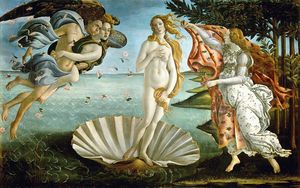
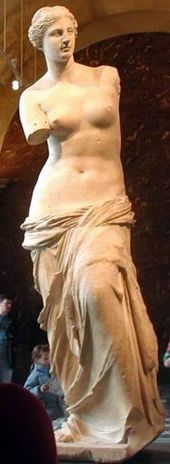

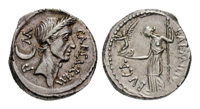
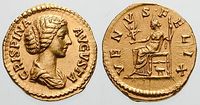
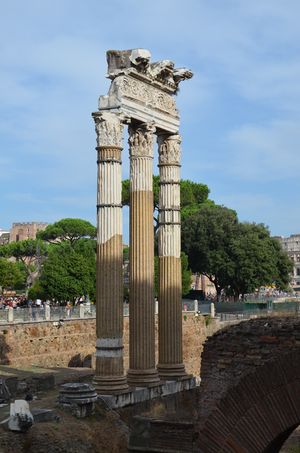
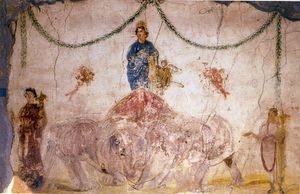











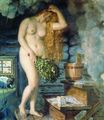
![Iris presenting the wounded Venus to Mars by Sir George Hayter, 1820 - Ante Library, Chatsworth House]]](/w/images/thumb/7/72/Iris_presenting_the_wounded_Venus_to_Mars_%28Venus%2C_supported_by_Iris%2C_complaining_to_Mars%29%2C_by_Sir_George_Hayter%2C_1820_-_Ante_Library%2C_Chatsworth_House_-_Derbyshire%2C_England_-_DSC03419.jpg/120px-Iris_presenting_the_wounded_Venus_to_Mars_%28Venus%2C_supported_by_Iris%2C_complaining_to_Mars%29%2C_by_Sir_George_Hayter%2C_1820_-_Ante_Library%2C_Chatsworth_House_-_Derbyshire%2C_England_-_DSC03419.jpg)

